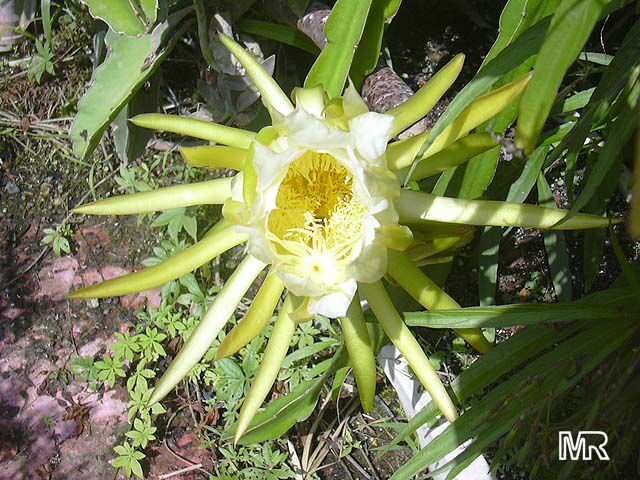Pitaya, Pitahaya
Dragon Fruit
- Scientific names: Ceraus, Acanthocereus, Echinocereus, Hylocereus, Selenicereus, Stenocereus, Escontria, Myrthillocactus.
- English common names: Pitaya, Dragon Fruit, Red Pitahaya, Night blooming Cereus, Strawberry Pear, Belle of the Night, conderella plant
- Other common names:
French: cierge-lezard, poire de chardon
German: distelbirn, echte stachelbirn, drachenfrucht
Hawaiian: Pa-nani-o-ka
Portoguese: cato-barse, cardo-ananaz
Spanish: pitahaya roja (Colombia, Mexico, Venezuela); flor de caliz, pitajava (Puerto Rico); junco, junco tapatio, pitahaya orejona, reina de la noche, tasajo (Mexico)
Swedish: skogskaktus, rod pitahaya - Size: vine-like crawling
- Exposure: full sun to shade; shade tolerant
- Water: little water, succulent
- Soil: Rich organic matter plus sand
- Origin: Central America
- Ethymology: Named for its undulate or wavy margins of the ribs
Order
Pitaya book from our store!
Buy
Pitaya plants from our store!
Synonymy
Cactus triangularis aphyllus Jacquin (1763) Stirp. Amer. 152
Cereus triangularis major de Candolle (1828) Prodr. 3:468
Cereus undatus Haworth (1830) Phil. Mag. 7:110
Cereus tricostatus Gosselin (1907) Bull. Soc. Bot. France 54:664
Hylocereus tricostatus (Gosselin) Britton & Rose (1909) Contr. U. S. Nat.
Herb. 12:429
Hylocereus undatus (Haworth) Britton & Rose (1918) Flora of Bermuda 256
History. There is a locally famous cacti hedge on a lava rock wall of the classy Punahou School in Honolulu. In 1836 Mrs. Bingham planted the hedge of Hylocereus undatus, the famed cacti known in Hawaii as panini o kapunahou. Its exotic blossoms still bloom during the closing summer months on the Punahou walls. The hedge is on two sides of the school and about three football fields long. From July to as late as October the hedge blooms and several times there is a wall of white flowers hundreds of yards long. Supposedly all the H. undatus in Hawaii came from the wall of Punahou Schooland. People used to come in the evenings from all over the island to see them blooming and "borrow" some cuttings so that now they have this species all over the islands.
The Pitaya is a specimen for dry tropical climates. Excessive rain leads to flower drop and fruit rot. Hardy to short frosts. Maximum tembetatures around 100F. Plants have aerial roots and originally exist as epiphytes. Aerial roots find nutritients in cracks where organic material concentrates. Propagation by stem cuttings. Flowers at night (one night only). Many species of pitaya are self-sterile, so moths and bets are required for cross-pollination.

Fruits are brightly colored (shades of red, pink, yellow) and are unique in appearance. Each weights 150-600g and contains many small edible seeds. Pulp varies from white to shades of red. Fruit set occurs 30-50 days after flowering, in 5-6 fruit crop cycles (May through November) a year. Freshly cut stems and flowers are used in preparation drugs which have spasmolytic effect on the coronary vessels and promote blood circulation.
More Pitaya pictures by Marina.
Cuttings
The growing speed with care are same for short or long cutting. It can growth 1.2 inchs per days. There is no different for short or long cutting. However, since some cutting are longer than other, it can reached the top of the pole (5.5 feets) faster than the short one. A good cutting can give fruit in within 6 months. The most of them can give fruit in within 9 months.

Red Pitahaya wine
6 lbs ripe red pitaya fruit, 2 lb sugar, 6 pts water, 1 crushed Campden tablet, 1 tsp pectic enzyme, 1 tsp yeast nutrient, 1 pkt wine yeast. Put water on to boil. Meanwhile, carefully trim the greenery from the fruit, wash the fruit well, and chop it coarsely. Put chopped fruit, sugar and yeast nutrient into primary. When water boils, pour into primary and stir until sugar dissolves. Cover with a sanitized cloth and set aside to cool. When at room temperature, add crushed Campden tablet and stir. Recover primary and set aside for 12 hours. Add pectic enzyme, stir, recover primary, and set aside another 12 hours. Add activated yeast. Stir daily for 7 days. Strain through nylon straining bag and squeeze juice out of red pitaya pulp. Transfer liquid to secondary, top up if required and fit airlock. Rack, top up and refit airlock every 30 days until wine clears and no new sediments form during a 30-day period. Stabilize, sweeten to taste, wait 10 days, and rack into bottles. Like most wines, it should improve with age. Recipe by Jack Keller.

The book by William Chow - 2004
This is a new book in 2004 specially made for beginners.
The book describes the general cultural practice for this plant.
Special attention is given to the problems encountered by beginners.
This book helps you to get the best harvest with less work.
References are included for Internet information and contacts to buy
the plant and the fruit.
Order
this book from our store!

Paul Thomson's Book on Pitahaya
The Pitahaya, Pitaya, or 'Dragon Fruit' is unknown to most gardening books. It is even omitted in the Sunset Western Gardening Book. The newly revised "Pitahaya - A Promising New Fruit Crop For Southern California" is a 46-page book printed on quality paper. Paul Thomson, experimenter and grower near San Diego, California, passes on insider information about culture, species descriptions, fruit quality, and his hybrids.
The revision has ten color pictures, including front and back, and eight color plates within contain a total of more than 50 pictures. The binding is wire ring, to allow the booklet to lie flat while open.
 Cactus fruit from Vietnam related to epiphyllum. Epiphyllum are called
orchid cactus because of the large and impressive flowers. Some epiphyllum
will bear fruit with cross pollination. Pitahaya is the Spainish name
for the fruiting vines from tropical Central America. The vine usually
has 3 ribs cross-section. The plant was imported to Vietnam. The pitahaya
will cross pollenate with the epiphyllum. The thornless dragon fruit is
a bit like the kiwi and can weight up to 3 pounds.
Cactus fruit from Vietnam related to epiphyllum. Epiphyllum are called
orchid cactus because of the large and impressive flowers. Some epiphyllum
will bear fruit with cross pollination. Pitahaya is the Spainish name
for the fruiting vines from tropical Central America. The vine usually
has 3 ribs cross-section. The plant was imported to Vietnam. The pitahaya
will cross pollenate with the epiphyllum. The thornless dragon fruit is
a bit like the kiwi and can weight up to 3 pounds.
 According to Quang Ong, this is how to get more flowers from the dragon
fruit. Use Bandini "Super Bloom" fertilizer, which has a 0-10-10
label (or 2-10-10). In the Western Garden Book, low nitrogen fertilizer
is recommended. In Paul Thomson's book, there is a discussion about avoiding
full sun and using shade to get more flowers and fruits.
According to Quang Ong, this is how to get more flowers from the dragon
fruit. Use Bandini "Super Bloom" fertilizer, which has a 0-10-10
label (or 2-10-10). In the Western Garden Book, low nitrogen fertilizer
is recommended. In Paul Thomson's book, there is a discussion about avoiding
full sun and using shade to get more flowers and fruits.

Useful information and links about Pitaya
All about Pitaya: A Research and Development Center for PITAYA
From daleysfruit.com:
Also known as the Dragon Fruit, the Pitaya is a stunningly beautiful fruit with an intense color and shape, magnificent flowers and a delicious taste. Once only seen in the finest restaurants it is fast becoming common-place throughout Australia as a garnish and a delicious fresh fruit. To eat the fruit serve chilled and cut in half. Scoop out the flesh and seeds much like a kiwi fruit.
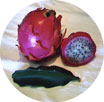 Hylocereus undatus is a red skinned climbing cactus that
has received world-wide recognition as an ornamental plant for its large,
scented, night-blooming flowers. It produces fruit of 1 kg or more and
has a light melon-like taste. The color of the skin is a beautiful bright
red, with translucent white flesh and tiny black seeds. The species is
easily recognisable by the triangular cross-section of its stem and minimal
spines. This species pollinates very well with Hylocereus polyrhizus.
Hylocereus undatus is a red skinned climbing cactus that
has received world-wide recognition as an ornamental plant for its large,
scented, night-blooming flowers. It produces fruit of 1 kg or more and
has a light melon-like taste. The color of the skin is a beautiful bright
red, with translucent white flesh and tiny black seeds. The species is
easily recognisable by the triangular cross-section of its stem and minimal
spines. This species pollinates very well with Hylocereus polyrhizus.
 Hylocereus polyrhizus has a small fruit up to 1
kg with red skin, dark-red flesh and small black seeds. The stems of this
species have more spines.
Hylocereus polyrhizus has a small fruit up to 1
kg with red skin, dark-red flesh and small black seeds. The stems of this
species have more spines.
 Selenicereus megalanthus has yellow skin and clear to
white flesh containing edible black seeds. It has smaller fruit and higher
levels of sugar. There are 2 types - Red and Yellow. The red although
very attractive is not as flavoursome as the yellow variety and requires
cross pollination. Harvest period - January to June.
Selenicereus megalanthus has yellow skin and clear to
white flesh containing edible black seeds. It has smaller fruit and higher
levels of sugar. There are 2 types - Red and Yellow. The red although
very attractive is not as flavoursome as the yellow variety and requires
cross pollination. Harvest period - January to June.Pitahaya and Epiphyllum from San Diego Epiphyllum Society
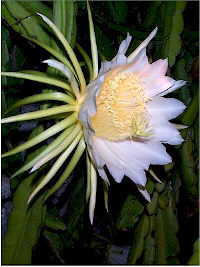
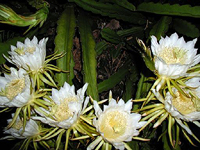
Hylocereus undatus
known in Hawaii
as panini o kapunahou.
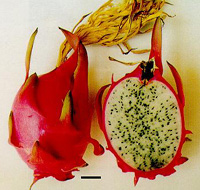
Yahoo
groups:
Pitaya And Other Dessert Fruiting Cacti (Ed Valdivia Leo Manuel - Group Owner
)
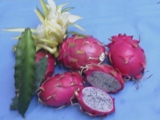
Pitaya, Pitahaya, Dragon Fruit, and other synonyms for Hylocereus undatus,
H. Polyrhizus, and other H. spp. are raised for their delicious and
attractive fruit.
Photo of Hylocereus undatus is by Ed Valdivia Leo Manuel


